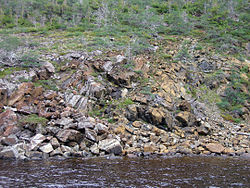- Mohorovičić discontinuity
-
 Ordovician ophiolite in Gros Morne National Park, Newfoundland. This rock which formed the Ordovician Moho is exposed on the surface.
Ordovician ophiolite in Gros Morne National Park, Newfoundland. This rock which formed the Ordovician Moho is exposed on the surface.
The Mohorovičić discontinuity (Croatian pronunciation: [mɔhɔˈrɔvitʃitɕ]) (MOE-HOE-ROE-vee-cheech), usually referred to as the Moho, is the boundary between the Earth's crust and the mantle. Named after the pioneering Croatian seismologist Andrija Mohorovičić, the Moho separates both the oceanic crust and continental crust from underlying mantle. The Moho mostly lies entirely within the lithosphere; only beneath mid-ocean ridges does it define the lithosphere – asthenosphere boundary. The Mohorovičić discontinuity was first identified in 1909 by Mohorovičić, when he observed that seismograms from shallow-focus earthquakes had two sets of P-waves and S-waves, one that followed a direct path near the Earth's surface and the other refracted by a high velocity medium.[1]
The Mohorovičić discontinuity is 5 to 10 kilometres (3–6 mi) below the ocean floor and 20 to 90 kilometres (10–60 mi) beneath typical continents, with an average of 35 kilometres (22 mi) beneath them.[2]
Contents
Nature of the Moho
Immediately above the Moho the velocities of primary seismic waves (P-waves) are approximately those of basalt (6.7 – 7.2 km/s), and below they are that of peridotitic or dunitic Earth-materials (7.6 – 8.6 km/s).[3] That suggests the Moho marks a change of composition, but the interface appears to be too even for any believable sorting mechanism within the Earth. Near-surface observations suggest such sorting produces an irregular surface. Some history of suggestions that the boundary marks instead a phase change controlled by a temperature gradient in the Earth can be found in Howell.[4]
Exploration
During the late 1950s and early 1960s, a proposal was taken up in the executive committee of the National Science Foundation to drill a hole through the ocean floor to reach this boundary. However the operation, named Project Mohole, never received sufficient support and was mismanaged; it was canceled by the United States Congress in 1967. Simultaneous efforts were made by the Soviet Union at the Kola Institute, which reached a depth of 12,260 metres (40,220 ft) over 15 years, the world's deepest hole until 2011, before that attempt was also abandoned in 1989.[5]
Reaching the discontinuity remains an important scientific objective. A more recent proposal considers a self-descending tungsten capsule heated by radiogenic heat to explore Earth's interior near the Moho discontinuity and in the upper mantle.[6] The Japanese project Chikyu Hakken ("Earth Discovery") also aims to explore this general area.
See also
References
Bibliography
- Harris, P. (1972). "The composition of the earth". In Gass, I. G. et al. (eds). Understanding the earth: a reader in the earth sciences. Horsham: Artemis Press for the Open University Press. ISBN 0-85141-308-0.
- "Schlumberger Oilfield Glossary". Schlumberger. http://www.glossary.oilfield.slb.com/default.cfm. Retrieved 2008-07-17.
- Dixon, Dougal (2000). Beginner's Guide to Geology. New York: Bounty Books. ISBN 0-7537-0358-0.
Notes
- ^ a b Andrew McLeish (1992). Geological science (2nd ed.). Thomas Nelson & Sons. p. 122. ISBN 0174482213. http://books.google.com/?id=rhkgwEvrVe8C&pg=PA122.
- ^ James Stewart Monroe, Reed Wicander (2008). The changing Earth: exploring geology and evolution (5th ed.). Cengage Learning. p. 216. ISBN 0495554804. http://books.google.com/?id=jFPMa4MxwJkC&pg=PA216.
- ^ RB Cathcart & MM Ćirković (2006). Viorel Badescu, Richard Brook Cathcart, Roelof D. Schuiling. ed. Macro-engineering: a challenge for the future. Springer. p. 169. ISBN 1402037392. http://books.google.com/?id=5bZBEM31K1MC&pg=PA169.
- ^ Benjamin Franklin Howell (1990). An introduction to seismological research: history and development. Cambridge University Press. p. 77 ff. ISBN 0521385717. http://books.google.com/?id=3LSW6xQxr0kC&pg=PA77.
- ^ "How the Soviets Drilled the Deepest Hole in the World". Wired. 2008-08-25. http://www.wired.com/science/discoveries/multimedia/2008/08/gallery_kola_borehole. Retrieved 2008-08-26.
- ^ Ozhovan, M.; F. Gibb, P. Poluektov and E. Emets (August 2005). "Probing of the Interior Layers of the Earth with Self-Sinking Capsules". Atomic Energy 99 (2): 556–562. doi:10.1007/s10512-005-0246-y.
External links
- Britt, Robert Roy (2005-04-07). "Hole Drilled to Bottom of Earth's Crust, Breakthrough to Mantle Looms". Imaginova. http://www.livescience.com/technology/050407_earth_drill.html. Retrieved 2008-07-17.
- "Digging a Hole in the Ocean: Project Mohole, 1958-1966". National Academy of Sciences. http://www.nas.edu/history/mohole/. Retrieved 2008-07-17.
- Map of the Moho depth of the European plate
Shells Discontinuities Conrad (continental crust) · Mohorovičić (crust–mantle) · Lehmann (upper mantle) · Gutenberg (mantle–core) · Lehmann (core) ·Arguments Categories:
Wikimedia Foundation. 2010.




